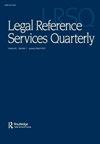Perma.cc and Web Archival Dissonance with Copyright Law
Q4 Social Sciences
引用次数: 1
Abstract
Abstract Harvard’s Perma.cc offers the solution to link rot—the phenomenon that citations in academic journals to Web materials disappear with the passage of time, resulting in “broken links” and disappearance of material from the Web. This article will describe Perma.cc and outline the kinds of copyright issues that may arise, including heavy use of copyright statutes and case law. It will examine the kind of preservation use of copyrighted materials, with reference to fair use, and the library prerogatives as exceptions to the exclusive rights of authors of materials found on the Web. This analysis includes detailed analysis of “transformative use” and the four factors of 17 U.S.C. § 107. It will consider the liability of Perma.cc and participating libraries and institutions under theories of contributory infringement and vicarious liability, including as modified by 17 U.S.C. § 512(c) and (d), governing takedown notices. The article concludes that Perma.cc’s archival use is neither firmly grounded in existing fair use nor library exemptions; that Perma.cc, its “registrar” library, institutional affiliates, and its contributors have some (at least theoretical) exposure to risk; and that current copyright doctrines and law do not adequately address Web archival storage for scholarly purposes. In doing so, it will question what the role of the scholarly Perma.cc citation ought to play—confirmation of scholarly propositions or preservation of and access to Web materials. The material and conclusions in this article are important for legal authors, law review editors, and librarians (especially those who use, support, or are considering partnering with Perma.cc) so that they might better assess copyright compliance, especially when selecting materials for archiving, such as articles from news sites, blogs, and professional and scholarly papers, articles, or books.层压。网络档案与著作权法的不协调
哈佛大学的Perma。cc提供了解决链接腐烂的方法,链接腐烂是指学术期刊对网络材料的引用随着时间的推移而消失,导致“断裂链接”和网络材料消失的现象。本文将介绍Perma。Cc并概述可能出现的各种版权问题,包括大量使用版权法规和判例法。它将根据合理使用,以及图书馆特权作为网络上发现的材料的作者专有权的例外,审查保护使用受版权保护的材料的类型。该分析包括对“变革性使用”和17 U.S.C.的四个因素的详细分析§107。它将考虑Perma的责任。cc和参与的图书馆和机构根据共同侵权和替代责任理论,包括经17 U.S.C.修改的条款§512(c)和(d)规定下架通知。文章的结论是:Cc的档案使用既不是基于现有的合理使用,也不是基于图书馆的豁免;层压。Cc、它的“注册”库、附属机构和它的贡献者都有一定的(至少理论上的)风险敞口;目前的版权理论和法律没有充分解决网络档案存储的学术目的。在这样做的过程中,它将质疑学术Perma的作用。抄写引用应该起到确认学术命题或保存和访问网络材料的作用。本文中的材料和结论对法律作者、法律评论编辑和图书馆员(特别是那些使用、支持或正在考虑与permacc合作的人)很重要,以便他们可以更好地评估版权合规性,特别是在选择要存档的材料时,例如来自新闻网站、博客、专业和学术论文、文章或书籍的文章。
本文章由计算机程序翻译,如有差异,请以英文原文为准。
求助全文
约1分钟内获得全文
求助全文
来源期刊

Legal Reference Services Quarterly
Social Sciences-Law
CiteScore
0.30
自引率
0.00%
发文量
13
期刊介绍:
An important forum for daily problems and issues, Legal Reference Services Quarterly will assist you in your day-to-day work as it has been helping other law librarians and members of the legal profession for over a decade. You will find articles that are serious, humorous, critical, or simply helpful to the working librarian. Annotated subject bibliographies, overviews of legal literature, reviews of commonly used tools, and the inclusion of reference problems unique to corporate law libraries, judicial libraries, and academic collections will keep you up-to-date on the continuously expanding volume of legal materials and their use in legal research.
 求助内容:
求助内容: 应助结果提醒方式:
应助结果提醒方式:


